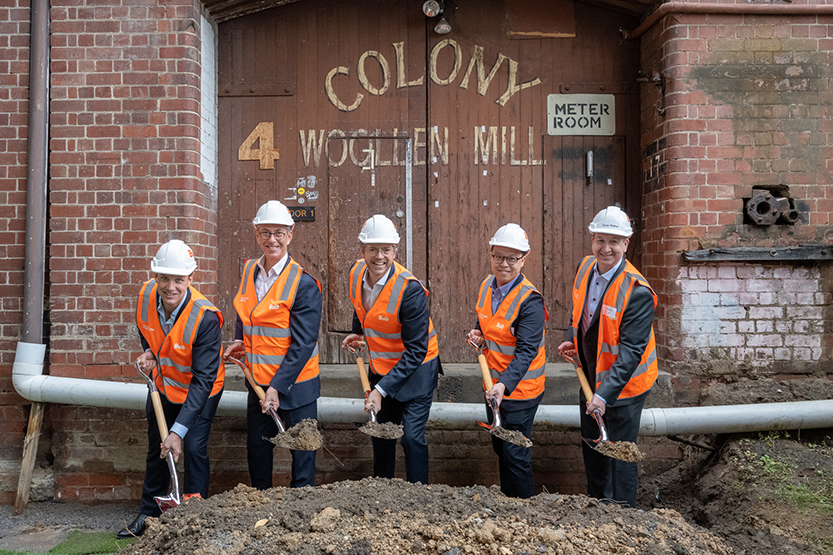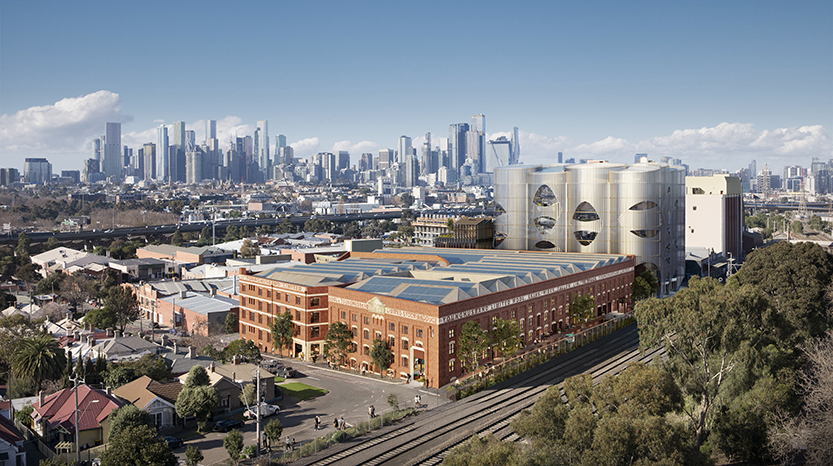Younghusband woolshed revamp starts
A new era for Kensington’s century-old former Younghusband Woolstores has been ushered in with construction of a major redevelopment of the site started in March.
The iconic red buildings have occupied the 2-50 Elizabeth St site for 122 years and are recognised as one of Melbourne’s biggest heritage sites.
But under a “reimagined Younghusband precinct” project, the 1.57-hectare site, which includes a network of early-20th-century industrial buildings, will be transformed into a “vibrant new destination village”, with a mix of office and retail spaces.
Since joining forces last year to acquire the site, Australian construction and development company Built, global investment group Ivanhoé Cambridge, and property investment and asset management group Irongate, have been working on upgrading plans to improve the design and sustainability aspects.
Construction for stage one began on March 28, which saw members of the three-way consortium and City of Melbourne Deputy Lord Mayor Nicholas Reece gather to celebrate the milestone occasion.
“Melbourne is blessed to have so many heritage buildings which have been preserved and, in many cases, enhanced, and that’s what we’re going to see on an epic scale with this Younghusband redevelopment,” Cr Reece said.
The Younghusband warehouses were originally bought by wool giant Younghusband & Co in 1902, which remained there in operation until the 1970s.
The buildings are among the last remaining wool stores in Victoria. In more recent decades, the complex has been home to arts and creative businesses as well as storing the Australian Ballet’s various goods.
Stage one of the Woods Bagot-designed plans proposes to preserve and showcase the architectural heritage of the two existing historic woolsheds, while converting them into 17,560 square metres of A-grade office space and adding a new town centre, “village-style” food and beverage outlets, and an “activated retail laneway that will bring new energy to the site throughout the day”.
The first two stages of the project have received planning approval, with construction under way on the first stage ahead of a mid-2024 completion.
A further 14,000 square metres will be added across two “sustainable and architecturally significant new buildings” in stage two of the project.
“This includes a new-build contemporary office building that references surrounding silos through a shimmering, permeable curved façade spanning seven levels and includes an adjoining glass-clad extension with hipped roofs that mimic the adjoining heritage buildings visual language while maintaining the historic façade to Elizabeth St,” according to the consortium’s vision for the project.
A third stage is currently pending approval, but it proposes for the corner of Chelmsford and Elizabeth streets to feature a further 13,300 square metres of A-grade office across a six-level building with “cascading greenery and a large public zone to encourage foot traffic, dwell and permeability through the precinct”.
Sustainability is front-of-mind for the project and its three stages, with targets including a 5.5 Star NABERS Office Energy (Base Building) 4.5 Star NABERS Water, 6-star Green Star Design, WELL Core v2 Gold and WELL Platinum, as well as being fully carbon-neutral.
Built managing director and CEO Brett Mason said tenants were being sought for stage one, with some of the largest flexible floor plates in the city on offer.
“Younghusband will create Melbourne’s largest carbon-neutral adaptive reuse precinct, reimagining and revitalising one of the city’s largest heritage sites and creating a connected and sustainable destination for work and play,” Mr Mason said.
With a design, and construction principles guided by sustainability and heritage preservation from the ground-up, Younghusband will create an environment where the past is respected and engineered for a sustainable future.
The newly unveiled plans are touted to represent Younghusband’s “greatest evolution,” while aligning with the state government’s vision for the Macaulay Precinct, a sentiment shared by the Deputy Lord Mayor.
By 2051, the precinct, which also includes North Melbourne, is expected to house 10,000 residents and 9500 jobs.
“The Macaulay Precinct is a really blessed little spot in Melbourne,” Cr Reece said, adding “there’s nothing that’s going to do that in a bigger way than what we’re seeing here at the Younghusband with this new development”.
“For many decades, this was the largest wool store in Australia – those days are now long gone. But we’ve been left with this incredible building, and through some imagination and human ingenuity, we’re going to see this building readapted and reused for the modern era.”
Ivanhoé Cambridge’s head of portfolio and asset management for Asia-Pacific, Rodney Fung, said, “The beginning of the construction of this mixed-use project is tangible evidence that Australia is a key part of our commitment to making all our development projects net-zero carbon from 2025.”
Irongate CEO Graeme Katz said it was of “upmost importance” that the project struck a balance with the requirements of community, commerciality, and heritage carefully, which he believed it did well, with the development to “produce a successful asset for both the community and investors for years to come”. •
Captions: (L-R) Built Development Director Jono Cottee, Irongate CEO Graeme Katz, Deputy Lord Mayor Nicholas Reece, Ivanhoe Cambridge Investment Asset Manager Edwin Tong, and Built National Director Ross Walker, and a render of the transformed Younghusband Woolsheds.

Jo Ryan unveils Ordered Chaos at Blender Studios






 Download the Latest Edition
Download the Latest Edition